EBUS616 Executing Projects: A Comparative Review of Maturity Models
VerifiedAdded on 2023/06/18
|14
|4101
|344
Report
AI Summary
This report provides a comprehensive review and comparison of various project management maturity models, including the Project Management Maturity Model (PMMM), Organizational Project Management Maturity Model (OPM3), and Portfolio, Programme and Project Management Maturity Model (P3M3). It discusses the different levels of maturity within each model, highlighting the benefits and criticisms associated with their implementation. The report also offers a comparative analysis of the models, evaluating their strengths and weaknesses in guiding organizations towards improved project management practices and strategic alignment. It concludes by emphasizing the importance of selecting the appropriate maturity model based on specific organizational needs and objectives.

EBUS 616
Paraphrase This Document
Need a fresh take? Get an instant paraphrase of this document with our AI Paraphraser
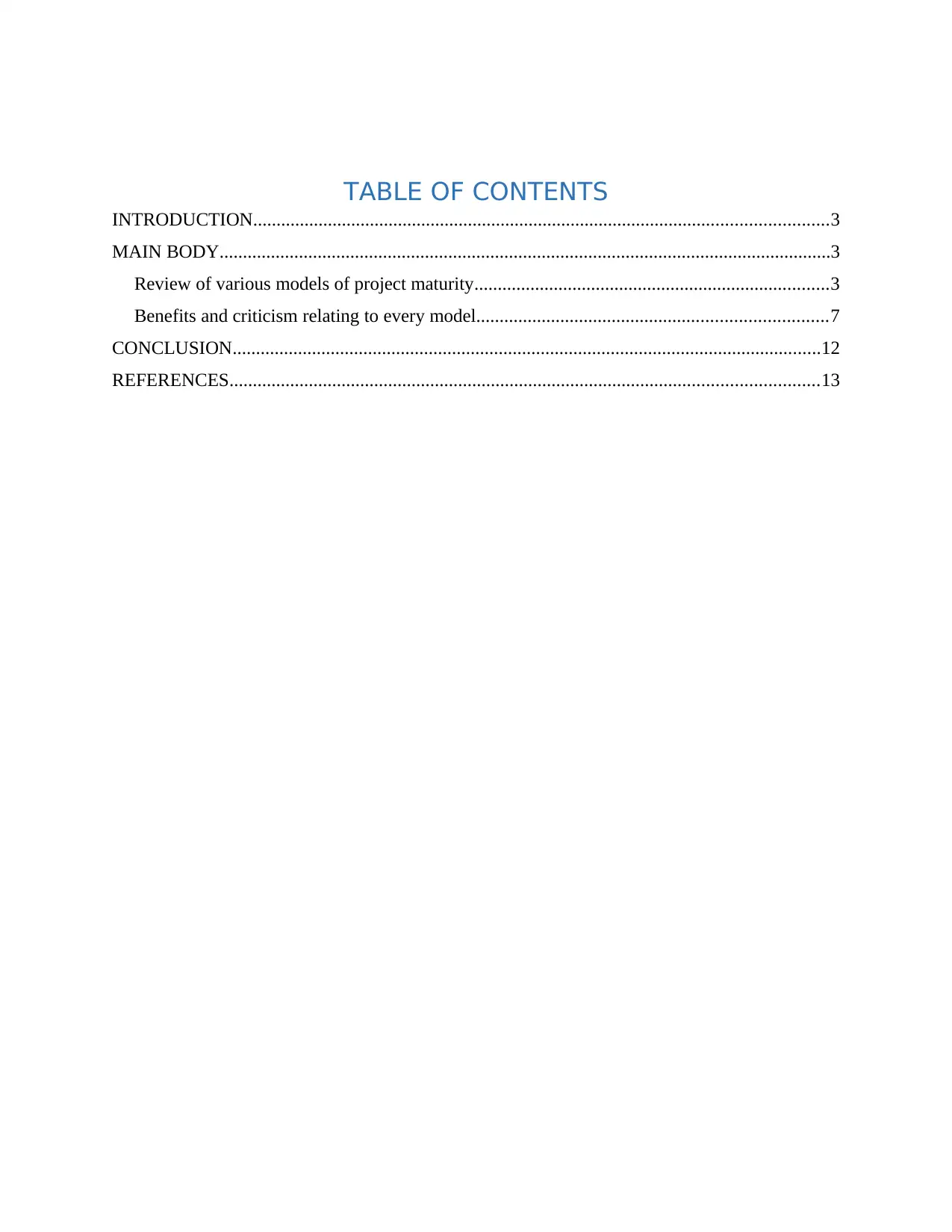
TABLE OF CONTENTS
INTRODUCTION...........................................................................................................................3
MAIN BODY...................................................................................................................................3
Review of various models of project maturity............................................................................3
Benefits and criticism relating to every model...........................................................................7
CONCLUSION..............................................................................................................................12
REFERENCES..............................................................................................................................13
INTRODUCTION...........................................................................................................................3
MAIN BODY...................................................................................................................................3
Review of various models of project maturity............................................................................3
Benefits and criticism relating to every model...........................................................................7
CONCLUSION..............................................................................................................................12
REFERENCES..............................................................................................................................13
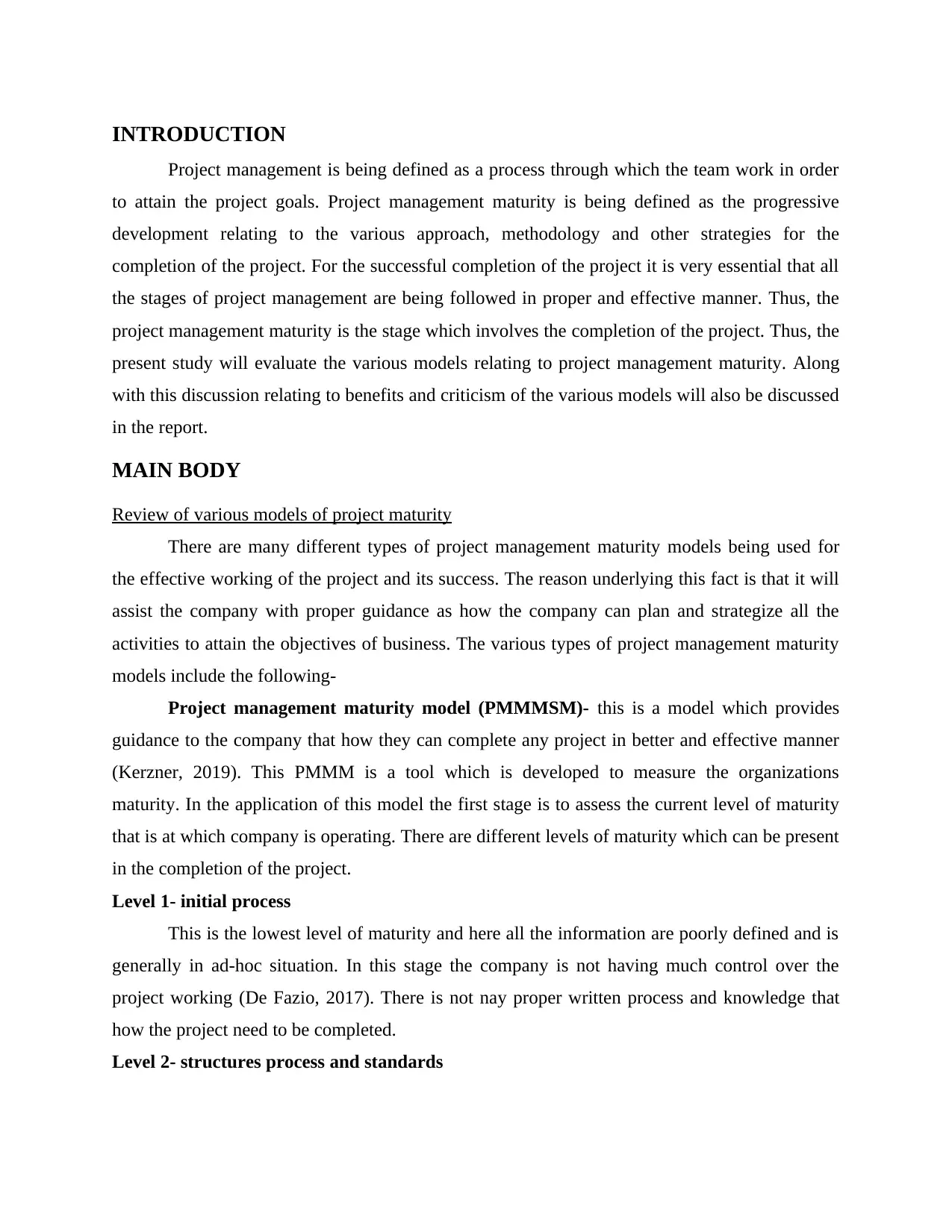
INTRODUCTION
Project management is being defined as a process through which the team work in order
to attain the project goals. Project management maturity is being defined as the progressive
development relating to the various approach, methodology and other strategies for the
completion of the project. For the successful completion of the project it is very essential that all
the stages of project management are being followed in proper and effective manner. Thus, the
project management maturity is the stage which involves the completion of the project. Thus, the
present study will evaluate the various models relating to project management maturity. Along
with this discussion relating to benefits and criticism of the various models will also be discussed
in the report.
MAIN BODY
Review of various models of project maturity
There are many different types of project management maturity models being used for
the effective working of the project and its success. The reason underlying this fact is that it will
assist the company with proper guidance as how the company can plan and strategize all the
activities to attain the objectives of business. The various types of project management maturity
models include the following-
Project management maturity model (PMMMSM)- this is a model which provides
guidance to the company that how they can complete any project in better and effective manner
(Kerzner, 2019). This PMMM is a tool which is developed to measure the organizations
maturity. In the application of this model the first stage is to assess the current level of maturity
that is at which company is operating. There are different levels of maturity which can be present
in the completion of the project.
Level 1- initial process
This is the lowest level of maturity and here all the information are poorly defined and is
generally in ad-hoc situation. In this stage the company is not having much control over the
project working (De Fazio, 2017). There is not nay proper written process and knowledge that
how the project need to be completed.
Level 2- structures process and standards
Project management is being defined as a process through which the team work in order
to attain the project goals. Project management maturity is being defined as the progressive
development relating to the various approach, methodology and other strategies for the
completion of the project. For the successful completion of the project it is very essential that all
the stages of project management are being followed in proper and effective manner. Thus, the
project management maturity is the stage which involves the completion of the project. Thus, the
present study will evaluate the various models relating to project management maturity. Along
with this discussion relating to benefits and criticism of the various models will also be discussed
in the report.
MAIN BODY
Review of various models of project maturity
There are many different types of project management maturity models being used for
the effective working of the project and its success. The reason underlying this fact is that it will
assist the company with proper guidance as how the company can plan and strategize all the
activities to attain the objectives of business. The various types of project management maturity
models include the following-
Project management maturity model (PMMMSM)- this is a model which provides
guidance to the company that how they can complete any project in better and effective manner
(Kerzner, 2019). This PMMM is a tool which is developed to measure the organizations
maturity. In the application of this model the first stage is to assess the current level of maturity
that is at which company is operating. There are different levels of maturity which can be present
in the completion of the project.
Level 1- initial process
This is the lowest level of maturity and here all the information are poorly defined and is
generally in ad-hoc situation. In this stage the company is not having much control over the
project working (De Fazio, 2017). There is not nay proper written process and knowledge that
how the project need to be completed.
Level 2- structures process and standards
⊘ This is a preview!⊘
Do you want full access?
Subscribe today to unlock all pages.

Trusted by 1+ million students worldwide
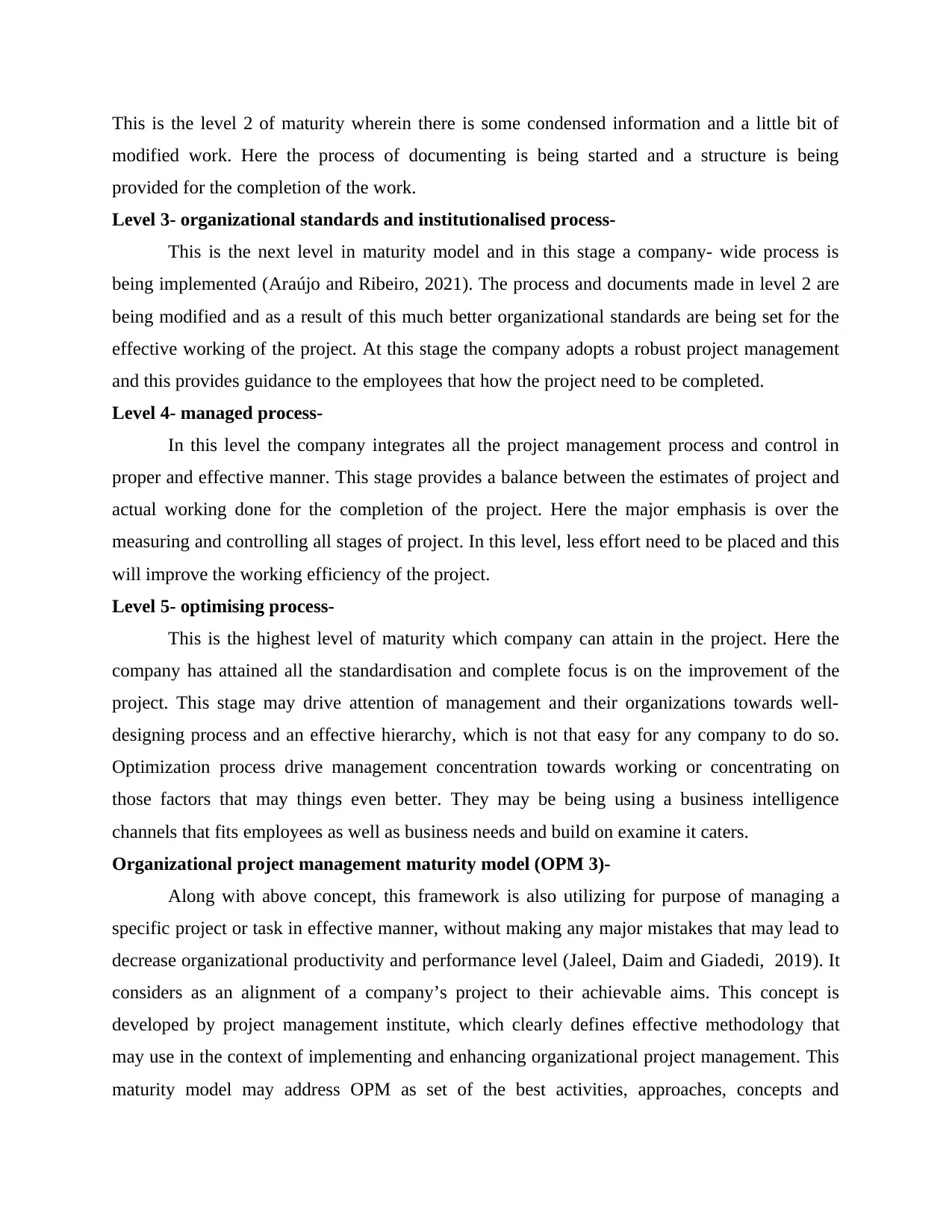
This is the level 2 of maturity wherein there is some condensed information and a little bit of
modified work. Here the process of documenting is being started and a structure is being
provided for the completion of the work.
Level 3- organizational standards and institutionalised process-
This is the next level in maturity model and in this stage a company- wide process is
being implemented (Araújo and Ribeiro, 2021). The process and documents made in level 2 are
being modified and as a result of this much better organizational standards are being set for the
effective working of the project. At this stage the company adopts a robust project management
and this provides guidance to the employees that how the project need to be completed.
Level 4- managed process-
In this level the company integrates all the project management process and control in
proper and effective manner. This stage provides a balance between the estimates of project and
actual working done for the completion of the project. Here the major emphasis is over the
measuring and controlling all stages of project. In this level, less effort need to be placed and this
will improve the working efficiency of the project.
Level 5- optimising process-
This is the highest level of maturity which company can attain in the project. Here the
company has attained all the standardisation and complete focus is on the improvement of the
project. This stage may drive attention of management and their organizations towards well-
designing process and an effective hierarchy, which is not that easy for any company to do so.
Optimization process drive management concentration towards working or concentrating on
those factors that may things even better. They may be being using a business intelligence
channels that fits employees as well as business needs and build on examine it caters.
Organizational project management maturity model (OPM 3)-
Along with above concept, this framework is also utilizing for purpose of managing a
specific project or task in effective manner, without making any major mistakes that may lead to
decrease organizational productivity and performance level (Jaleel, Daim and Giadedi, 2019). It
considers as an alignment of a company’s project to their achievable aims. This concept is
developed by project management institute, which clearly defines effective methodology that
may use in the context of implementing and enhancing organizational project management. This
maturity model may address OPM as set of the best activities, approaches, concepts and
modified work. Here the process of documenting is being started and a structure is being
provided for the completion of the work.
Level 3- organizational standards and institutionalised process-
This is the next level in maturity model and in this stage a company- wide process is
being implemented (Araújo and Ribeiro, 2021). The process and documents made in level 2 are
being modified and as a result of this much better organizational standards are being set for the
effective working of the project. At this stage the company adopts a robust project management
and this provides guidance to the employees that how the project need to be completed.
Level 4- managed process-
In this level the company integrates all the project management process and control in
proper and effective manner. This stage provides a balance between the estimates of project and
actual working done for the completion of the project. Here the major emphasis is over the
measuring and controlling all stages of project. In this level, less effort need to be placed and this
will improve the working efficiency of the project.
Level 5- optimising process-
This is the highest level of maturity which company can attain in the project. Here the
company has attained all the standardisation and complete focus is on the improvement of the
project. This stage may drive attention of management and their organizations towards well-
designing process and an effective hierarchy, which is not that easy for any company to do so.
Optimization process drive management concentration towards working or concentrating on
those factors that may things even better. They may be being using a business intelligence
channels that fits employees as well as business needs and build on examine it caters.
Organizational project management maturity model (OPM 3)-
Along with above concept, this framework is also utilizing for purpose of managing a
specific project or task in effective manner, without making any major mistakes that may lead to
decrease organizational productivity and performance level (Jaleel, Daim and Giadedi, 2019). It
considers as an alignment of a company’s project to their achievable aims. This concept is
developed by project management institute, which clearly defines effective methodology that
may use in the context of implementing and enhancing organizational project management. This
maturity model may address OPM as set of the best activities, approaches, concepts and
Paraphrase This Document
Need a fresh take? Get an instant paraphrase of this document with our AI Paraphraser
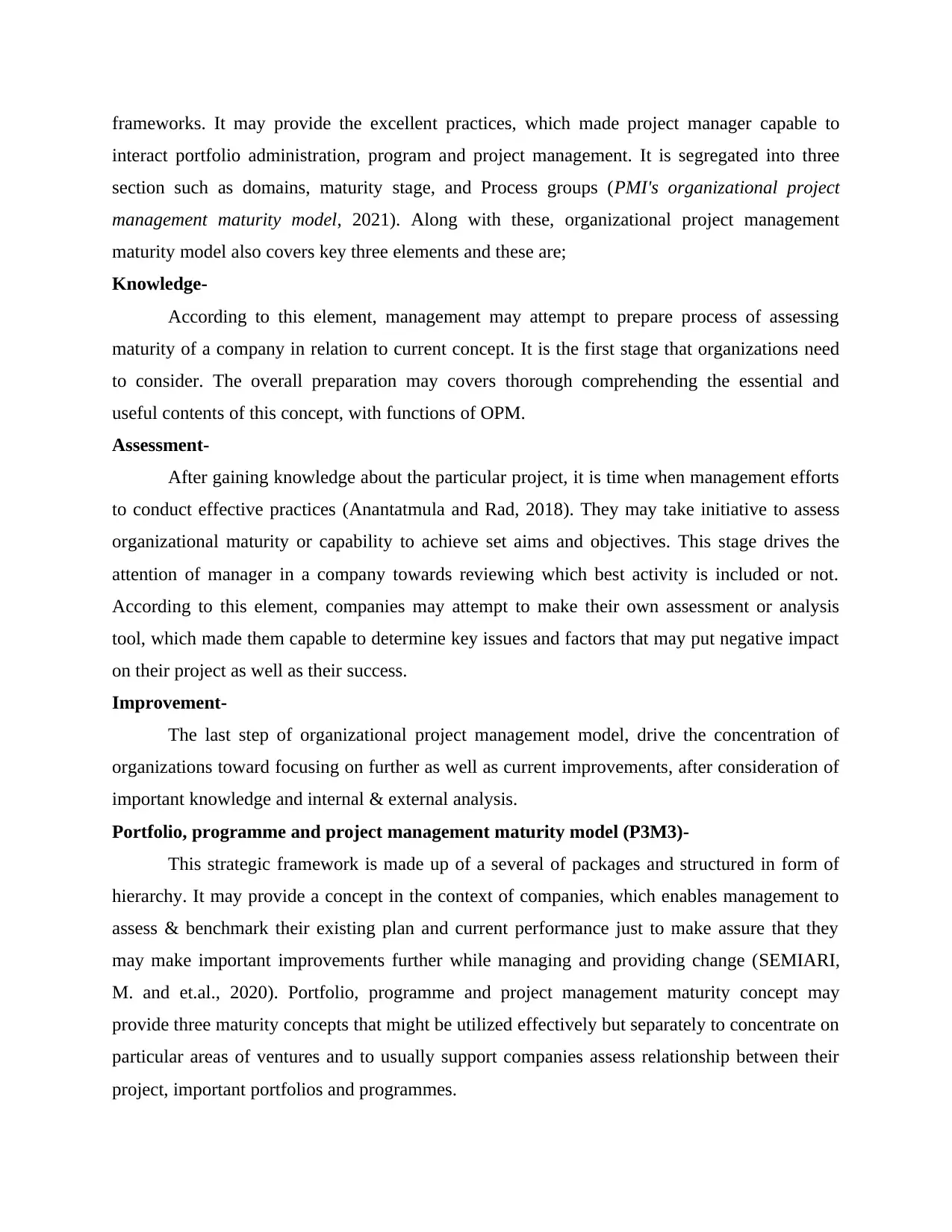
frameworks. It may provide the excellent practices, which made project manager capable to
interact portfolio administration, program and project management. It is segregated into three
section such as domains, maturity stage, and Process groups (PMI's organizational project
management maturity model, 2021). Along with these, organizational project management
maturity model also covers key three elements and these are;
Knowledge-
According to this element, management may attempt to prepare process of assessing
maturity of a company in relation to current concept. It is the first stage that organizations need
to consider. The overall preparation may covers thorough comprehending the essential and
useful contents of this concept, with functions of OPM.
Assessment-
After gaining knowledge about the particular project, it is time when management efforts
to conduct effective practices (Anantatmula and Rad, 2018). They may take initiative to assess
organizational maturity or capability to achieve set aims and objectives. This stage drives the
attention of manager in a company towards reviewing which best activity is included or not.
According to this element, companies may attempt to make their own assessment or analysis
tool, which made them capable to determine key issues and factors that may put negative impact
on their project as well as their success.
Improvement-
The last step of organizational project management model, drive the concentration of
organizations toward focusing on further as well as current improvements, after consideration of
important knowledge and internal & external analysis.
Portfolio, programme and project management maturity model (P3M3)-
This strategic framework is made up of a several of packages and structured in form of
hierarchy. It may provide a concept in the context of companies, which enables management to
assess & benchmark their existing plan and current performance just to make assure that they
may make important improvements further while managing and providing change (SEMIARI,
M. and et.al., 2020). Portfolio, programme and project management maturity concept may
provide three maturity concepts that might be utilized effectively but separately to concentrate on
particular areas of ventures and to usually support companies assess relationship between their
project, important portfolios and programmes.
interact portfolio administration, program and project management. It is segregated into three
section such as domains, maturity stage, and Process groups (PMI's organizational project
management maturity model, 2021). Along with these, organizational project management
maturity model also covers key three elements and these are;
Knowledge-
According to this element, management may attempt to prepare process of assessing
maturity of a company in relation to current concept. It is the first stage that organizations need
to consider. The overall preparation may covers thorough comprehending the essential and
useful contents of this concept, with functions of OPM.
Assessment-
After gaining knowledge about the particular project, it is time when management efforts
to conduct effective practices (Anantatmula and Rad, 2018). They may take initiative to assess
organizational maturity or capability to achieve set aims and objectives. This stage drives the
attention of manager in a company towards reviewing which best activity is included or not.
According to this element, companies may attempt to make their own assessment or analysis
tool, which made them capable to determine key issues and factors that may put negative impact
on their project as well as their success.
Improvement-
The last step of organizational project management model, drive the concentration of
organizations toward focusing on further as well as current improvements, after consideration of
important knowledge and internal & external analysis.
Portfolio, programme and project management maturity model (P3M3)-
This strategic framework is made up of a several of packages and structured in form of
hierarchy. It may provide a concept in the context of companies, which enables management to
assess & benchmark their existing plan and current performance just to make assure that they
may make important improvements further while managing and providing change (SEMIARI,
M. and et.al., 2020). Portfolio, programme and project management maturity concept may
provide three maturity concepts that might be utilized effectively but separately to concentrate on
particular areas of ventures and to usually support companies assess relationship between their
project, important portfolios and programmes.
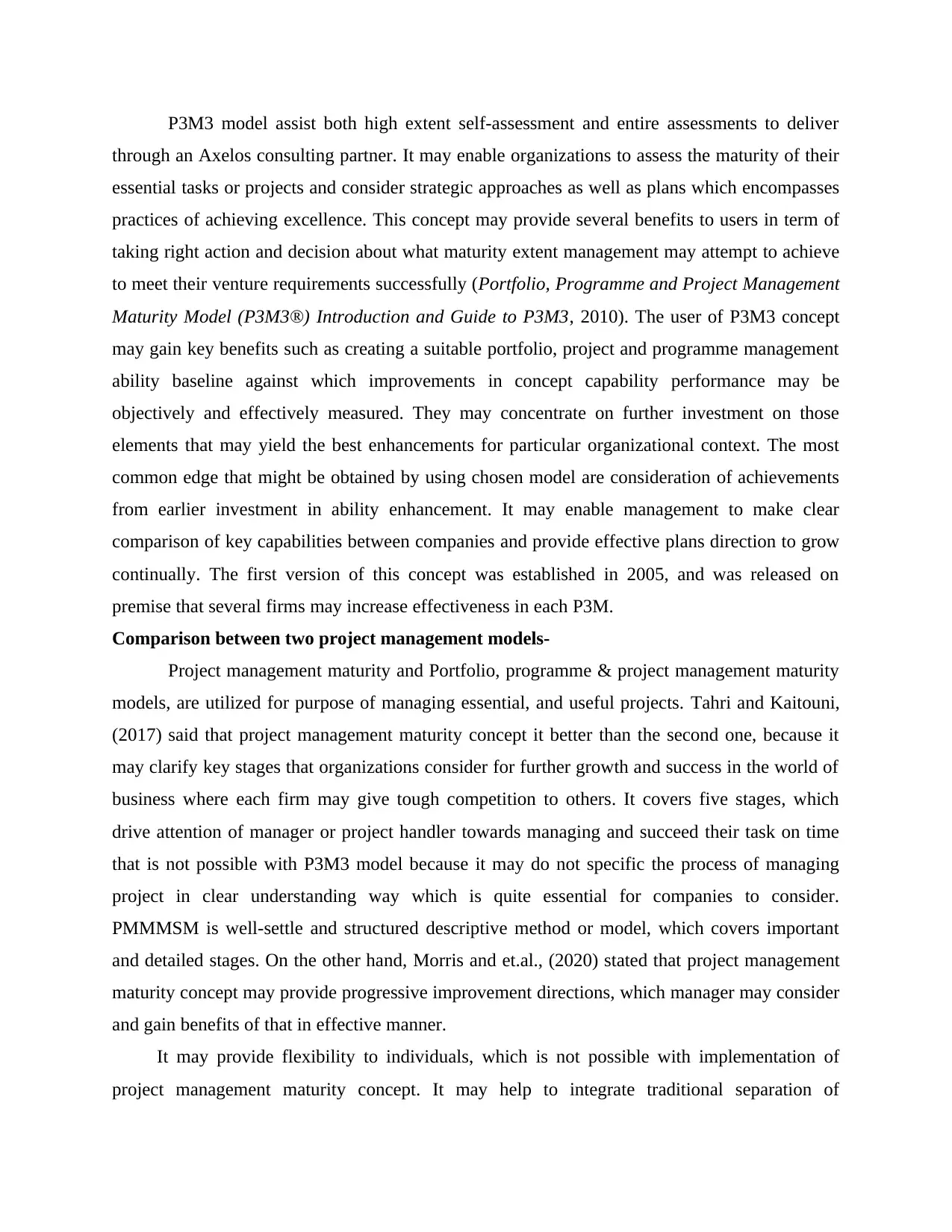
P3M3 model assist both high extent self-assessment and entire assessments to deliver
through an Axelos consulting partner. It may enable organizations to assess the maturity of their
essential tasks or projects and consider strategic approaches as well as plans which encompasses
practices of achieving excellence. This concept may provide several benefits to users in term of
taking right action and decision about what maturity extent management may attempt to achieve
to meet their venture requirements successfully (Portfolio, Programme and Project Management
Maturity Model (P3M3®) Introduction and Guide to P3M3, 2010). The user of P3M3 concept
may gain key benefits such as creating a suitable portfolio, project and programme management
ability baseline against which improvements in concept capability performance may be
objectively and effectively measured. They may concentrate on further investment on those
elements that may yield the best enhancements for particular organizational context. The most
common edge that might be obtained by using chosen model are consideration of achievements
from earlier investment in ability enhancement. It may enable management to make clear
comparison of key capabilities between companies and provide effective plans direction to grow
continually. The first version of this concept was established in 2005, and was released on
premise that several firms may increase effectiveness in each P3M.
Comparison between two project management models-
Project management maturity and Portfolio, programme & project management maturity
models, are utilized for purpose of managing essential, and useful projects. Tahri and Kaitouni,
(2017) said that project management maturity concept it better than the second one, because it
may clarify key stages that organizations consider for further growth and success in the world of
business where each firm may give tough competition to others. It covers five stages, which
drive attention of manager or project handler towards managing and succeed their task on time
that is not possible with P3M3 model because it may do not specific the process of managing
project in clear understanding way which is quite essential for companies to consider.
PMMMSM is well-settle and structured descriptive method or model, which covers important
and detailed stages. On the other hand, Morris and et.al., (2020) stated that project management
maturity concept may provide progressive improvement directions, which manager may consider
and gain benefits of that in effective manner.
It may provide flexibility to individuals, which is not possible with implementation of
project management maturity concept. It may help to integrate traditional separation of
through an Axelos consulting partner. It may enable organizations to assess the maturity of their
essential tasks or projects and consider strategic approaches as well as plans which encompasses
practices of achieving excellence. This concept may provide several benefits to users in term of
taking right action and decision about what maturity extent management may attempt to achieve
to meet their venture requirements successfully (Portfolio, Programme and Project Management
Maturity Model (P3M3®) Introduction and Guide to P3M3, 2010). The user of P3M3 concept
may gain key benefits such as creating a suitable portfolio, project and programme management
ability baseline against which improvements in concept capability performance may be
objectively and effectively measured. They may concentrate on further investment on those
elements that may yield the best enhancements for particular organizational context. The most
common edge that might be obtained by using chosen model are consideration of achievements
from earlier investment in ability enhancement. It may enable management to make clear
comparison of key capabilities between companies and provide effective plans direction to grow
continually. The first version of this concept was established in 2005, and was released on
premise that several firms may increase effectiveness in each P3M.
Comparison between two project management models-
Project management maturity and Portfolio, programme & project management maturity
models, are utilized for purpose of managing essential, and useful projects. Tahri and Kaitouni,
(2017) said that project management maturity concept it better than the second one, because it
may clarify key stages that organizations consider for further growth and success in the world of
business where each firm may give tough competition to others. It covers five stages, which
drive attention of manager or project handler towards managing and succeed their task on time
that is not possible with P3M3 model because it may do not specific the process of managing
project in clear understanding way which is quite essential for companies to consider.
PMMMSM is well-settle and structured descriptive method or model, which covers important
and detailed stages. On the other hand, Morris and et.al., (2020) stated that project management
maturity concept may provide progressive improvement directions, which manager may consider
and gain benefits of that in effective manner.
It may provide flexibility to individuals, which is not possible with implementation of
project management maturity concept. It may help to integrate traditional separation of
⊘ This is a preview!⊘
Do you want full access?
Subscribe today to unlock all pages.

Trusted by 1+ million students worldwide
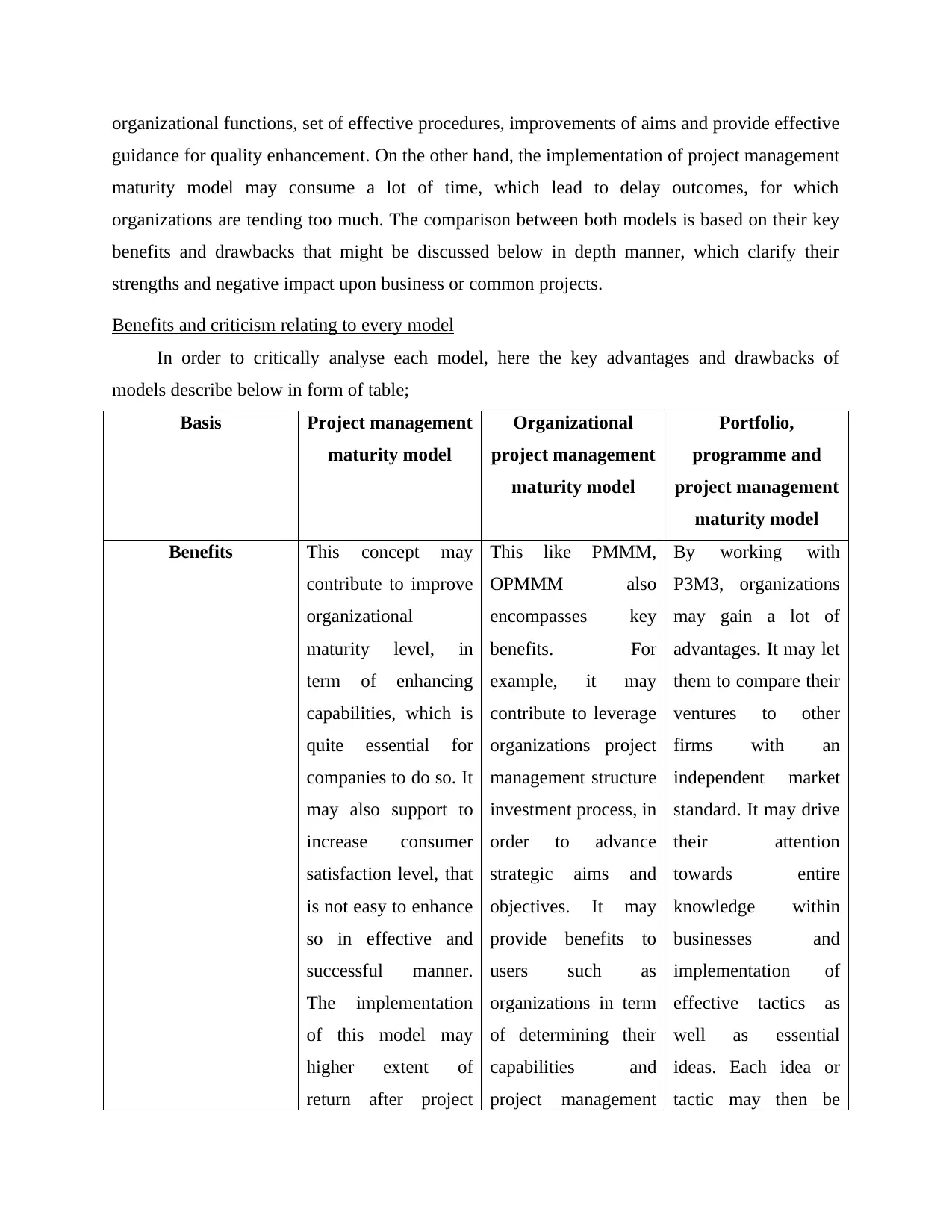
organizational functions, set of effective procedures, improvements of aims and provide effective
guidance for quality enhancement. On the other hand, the implementation of project management
maturity model may consume a lot of time, which lead to delay outcomes, for which
organizations are tending too much. The comparison between both models is based on their key
benefits and drawbacks that might be discussed below in depth manner, which clarify their
strengths and negative impact upon business or common projects.
Benefits and criticism relating to every model
In order to critically analyse each model, here the key advantages and drawbacks of
models describe below in form of table;
Basis Project management
maturity model
Organizational
project management
maturity model
Portfolio,
programme and
project management
maturity model
Benefits This concept may
contribute to improve
organizational
maturity level, in
term of enhancing
capabilities, which is
quite essential for
companies to do so. It
may also support to
increase consumer
satisfaction level, that
is not easy to enhance
so in effective and
successful manner.
The implementation
of this model may
higher extent of
return after project
This like PMMM,
OPMMM also
encompasses key
benefits. For
example, it may
contribute to leverage
organizations project
management structure
investment process, in
order to advance
strategic aims and
objectives. It may
provide benefits to
users such as
organizations in term
of determining their
capabilities and
project management
By working with
P3M3, organizations
may gain a lot of
advantages. It may let
them to compare their
ventures to other
firms with an
independent market
standard. It may drive
their attention
towards entire
knowledge within
businesses and
implementation of
effective tactics as
well as essential
ideas. Each idea or
tactic may then be
guidance for quality enhancement. On the other hand, the implementation of project management
maturity model may consume a lot of time, which lead to delay outcomes, for which
organizations are tending too much. The comparison between both models is based on their key
benefits and drawbacks that might be discussed below in depth manner, which clarify their
strengths and negative impact upon business or common projects.
Benefits and criticism relating to every model
In order to critically analyse each model, here the key advantages and drawbacks of
models describe below in form of table;
Basis Project management
maturity model
Organizational
project management
maturity model
Portfolio,
programme and
project management
maturity model
Benefits This concept may
contribute to improve
organizational
maturity level, in
term of enhancing
capabilities, which is
quite essential for
companies to do so. It
may also support to
increase consumer
satisfaction level, that
is not easy to enhance
so in effective and
successful manner.
The implementation
of this model may
higher extent of
return after project
This like PMMM,
OPMMM also
encompasses key
benefits. For
example, it may
contribute to leverage
organizations project
management structure
investment process, in
order to advance
strategic aims and
objectives. It may
provide benefits to
users such as
organizations in term
of determining their
capabilities and
project management
By working with
P3M3, organizations
may gain a lot of
advantages. It may let
them to compare their
ventures to other
firms with an
independent market
standard. It may drive
their attention
towards entire
knowledge within
businesses and
implementation of
effective tactics as
well as essential
ideas. Each idea or
tactic may then be
Paraphrase This Document
Need a fresh take? Get an instant paraphrase of this document with our AI Paraphraser
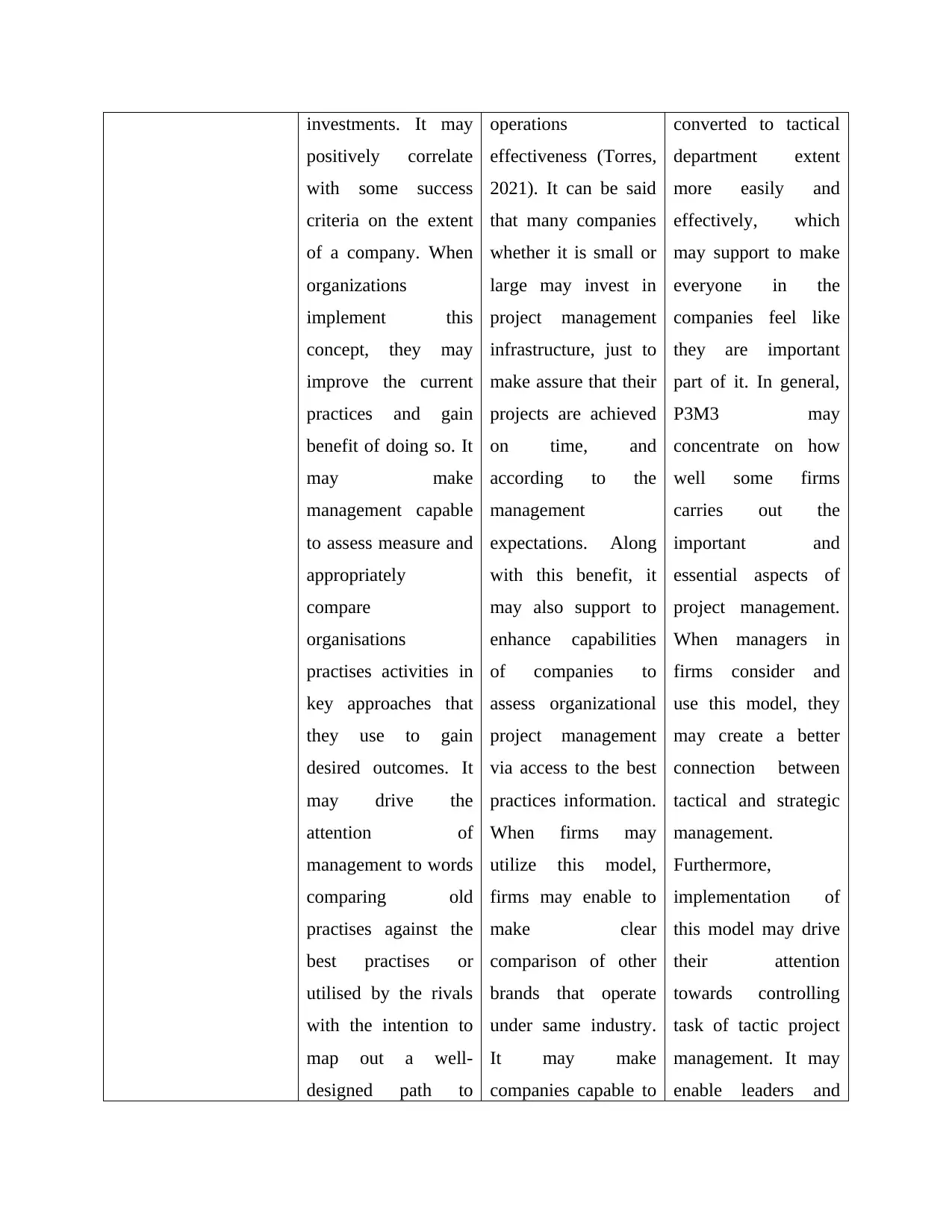
investments. It may
positively correlate
with some success
criteria on the extent
of a company. When
organizations
implement this
concept, they may
improve the current
practices and gain
benefit of doing so. It
may make
management capable
to assess measure and
appropriately
compare
organisations
practises activities in
key approaches that
they use to gain
desired outcomes. It
may drive the
attention of
management to words
comparing old
practises against the
best practises or
utilised by the rivals
with the intention to
map out a well-
designed path to
operations
effectiveness (Torres,
2021). It can be said
that many companies
whether it is small or
large may invest in
project management
infrastructure, just to
make assure that their
projects are achieved
on time, and
according to the
management
expectations. Along
with this benefit, it
may also support to
enhance capabilities
of companies to
assess organizational
project management
via access to the best
practices information.
When firms may
utilize this model,
firms may enable to
make clear
comparison of other
brands that operate
under same industry.
It may make
companies capable to
converted to tactical
department extent
more easily and
effectively, which
may support to make
everyone in the
companies feel like
they are important
part of it. In general,
P3M3 may
concentrate on how
well some firms
carries out the
important and
essential aspects of
project management.
When managers in
firms consider and
use this model, they
may create a better
connection between
tactical and strategic
management.
Furthermore,
implementation of
this model may drive
their attention
towards controlling
task of tactic project
management. It may
enable leaders and
positively correlate
with some success
criteria on the extent
of a company. When
organizations
implement this
concept, they may
improve the current
practices and gain
benefit of doing so. It
may make
management capable
to assess measure and
appropriately
compare
organisations
practises activities in
key approaches that
they use to gain
desired outcomes. It
may drive the
attention of
management to words
comparing old
practises against the
best practises or
utilised by the rivals
with the intention to
map out a well-
designed path to
operations
effectiveness (Torres,
2021). It can be said
that many companies
whether it is small or
large may invest in
project management
infrastructure, just to
make assure that their
projects are achieved
on time, and
according to the
management
expectations. Along
with this benefit, it
may also support to
enhance capabilities
of companies to
assess organizational
project management
via access to the best
practices information.
When firms may
utilize this model,
firms may enable to
make clear
comparison of other
brands that operate
under same industry.
It may make
companies capable to
converted to tactical
department extent
more easily and
effectively, which
may support to make
everyone in the
companies feel like
they are important
part of it. In general,
P3M3 may
concentrate on how
well some firms
carries out the
important and
essential aspects of
project management.
When managers in
firms consider and
use this model, they
may create a better
connection between
tactical and strategic
management.
Furthermore,
implementation of
this model may drive
their attention
towards controlling
task of tactic project
management. It may
enable leaders and
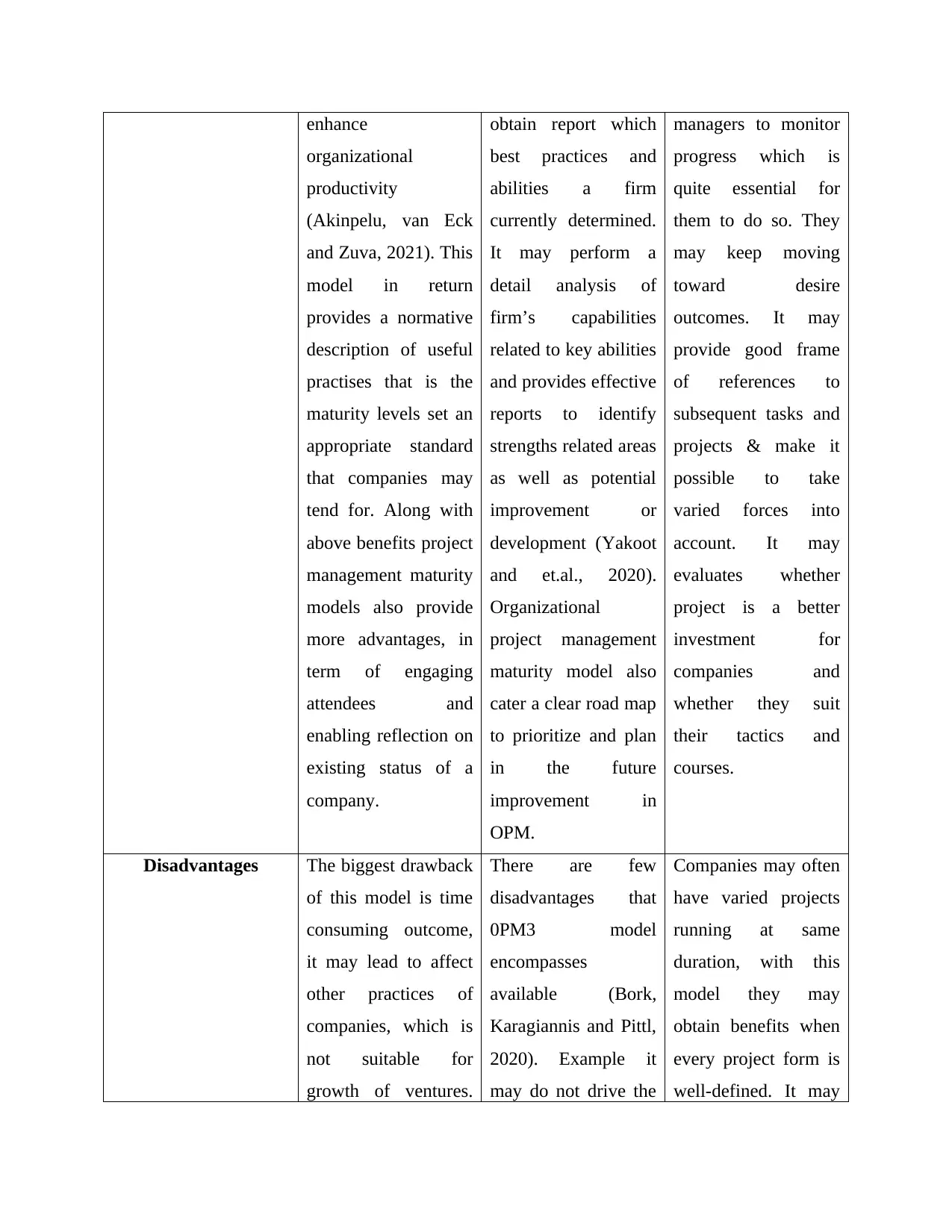
enhance
organizational
productivity
(Akinpelu, van Eck
and Zuva, 2021). This
model in return
provides a normative
description of useful
practises that is the
maturity levels set an
appropriate standard
that companies may
tend for. Along with
above benefits project
management maturity
models also provide
more advantages, in
term of engaging
attendees and
enabling reflection on
existing status of a
company.
obtain report which
best practices and
abilities a firm
currently determined.
It may perform a
detail analysis of
firm’s capabilities
related to key abilities
and provides effective
reports to identify
strengths related areas
as well as potential
improvement or
development (Yakoot
and et.al., 2020).
Organizational
project management
maturity model also
cater a clear road map
to prioritize and plan
in the future
improvement in
OPM.
managers to monitor
progress which is
quite essential for
them to do so. They
may keep moving
toward desire
outcomes. It may
provide good frame
of references to
subsequent tasks and
projects & make it
possible to take
varied forces into
account. It may
evaluates whether
project is a better
investment for
companies and
whether they suit
their tactics and
courses.
Disadvantages The biggest drawback
of this model is time
consuming outcome,
it may lead to affect
other practices of
companies, which is
not suitable for
growth of ventures.
There are few
disadvantages that
0PM3 model
encompasses
available (Bork,
Karagiannis and Pittl,
2020). Example it
may do not drive the
Companies may often
have varied projects
running at same
duration, with this
model they may
obtain benefits when
every project form is
well-defined. It may
organizational
productivity
(Akinpelu, van Eck
and Zuva, 2021). This
model in return
provides a normative
description of useful
practises that is the
maturity levels set an
appropriate standard
that companies may
tend for. Along with
above benefits project
management maturity
models also provide
more advantages, in
term of engaging
attendees and
enabling reflection on
existing status of a
company.
obtain report which
best practices and
abilities a firm
currently determined.
It may perform a
detail analysis of
firm’s capabilities
related to key abilities
and provides effective
reports to identify
strengths related areas
as well as potential
improvement or
development (Yakoot
and et.al., 2020).
Organizational
project management
maturity model also
cater a clear road map
to prioritize and plan
in the future
improvement in
OPM.
managers to monitor
progress which is
quite essential for
them to do so. They
may keep moving
toward desire
outcomes. It may
provide good frame
of references to
subsequent tasks and
projects & make it
possible to take
varied forces into
account. It may
evaluates whether
project is a better
investment for
companies and
whether they suit
their tactics and
courses.
Disadvantages The biggest drawback
of this model is time
consuming outcome,
it may lead to affect
other practices of
companies, which is
not suitable for
growth of ventures.
There are few
disadvantages that
0PM3 model
encompasses
available (Bork,
Karagiannis and Pittl,
2020). Example it
may do not drive the
Companies may often
have varied projects
running at same
duration, with this
model they may
obtain benefits when
every project form is
well-defined. It may
⊘ This is a preview!⊘
Do you want full access?
Subscribe today to unlock all pages.

Trusted by 1+ million students worldwide
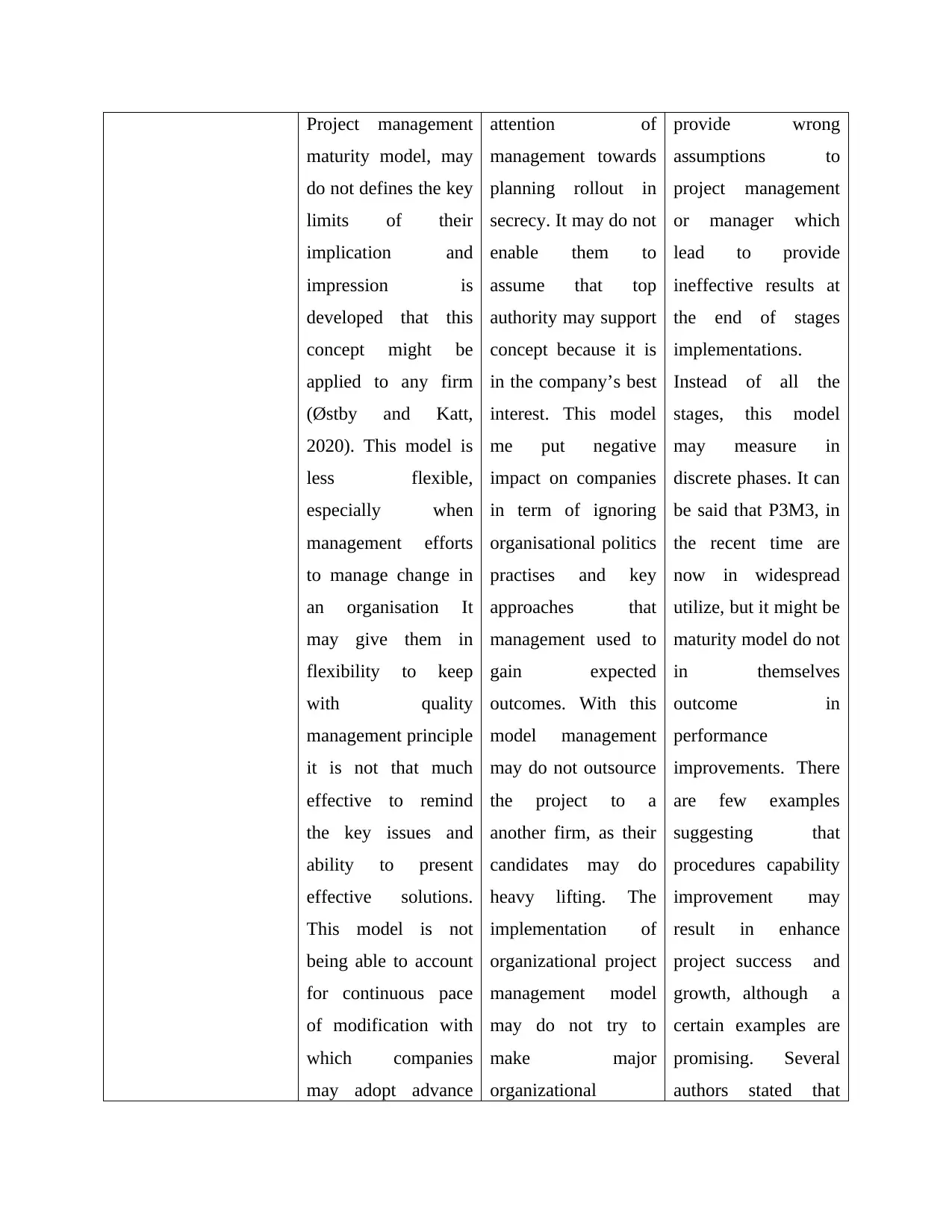
Project management
maturity model, may
do not defines the key
limits of their
implication and
impression is
developed that this
concept might be
applied to any firm
(Østby and Katt,
2020). This model is
less flexible,
especially when
management efforts
to manage change in
an organisation It
may give them in
flexibility to keep
with quality
management principle
it is not that much
effective to remind
the key issues and
ability to present
effective solutions.
This model is not
being able to account
for continuous pace
of modification with
which companies
may adopt advance
attention of
management towards
planning rollout in
secrecy. It may do not
enable them to
assume that top
authority may support
concept because it is
in the company’s best
interest. This model
me put negative
impact on companies
in term of ignoring
organisational politics
practises and key
approaches that
management used to
gain expected
outcomes. With this
model management
may do not outsource
the project to a
another firm, as their
candidates may do
heavy lifting. The
implementation of
organizational project
management model
may do not try to
make major
organizational
provide wrong
assumptions to
project management
or manager which
lead to provide
ineffective results at
the end of stages
implementations.
Instead of all the
stages, this model
may measure in
discrete phases. It can
be said that P3M3, in
the recent time are
now in widespread
utilize, but it might be
maturity model do not
in themselves
outcome in
performance
improvements. There
are few examples
suggesting that
procedures capability
improvement may
result in enhance
project success and
growth, although a
certain examples are
promising. Several
authors stated that
maturity model, may
do not defines the key
limits of their
implication and
impression is
developed that this
concept might be
applied to any firm
(Østby and Katt,
2020). This model is
less flexible,
especially when
management efforts
to manage change in
an organisation It
may give them in
flexibility to keep
with quality
management principle
it is not that much
effective to remind
the key issues and
ability to present
effective solutions.
This model is not
being able to account
for continuous pace
of modification with
which companies
may adopt advance
attention of
management towards
planning rollout in
secrecy. It may do not
enable them to
assume that top
authority may support
concept because it is
in the company’s best
interest. This model
me put negative
impact on companies
in term of ignoring
organisational politics
practises and key
approaches that
management used to
gain expected
outcomes. With this
model management
may do not outsource
the project to a
another firm, as their
candidates may do
heavy lifting. The
implementation of
organizational project
management model
may do not try to
make major
organizational
provide wrong
assumptions to
project management
or manager which
lead to provide
ineffective results at
the end of stages
implementations.
Instead of all the
stages, this model
may measure in
discrete phases. It can
be said that P3M3, in
the recent time are
now in widespread
utilize, but it might be
maturity model do not
in themselves
outcome in
performance
improvements. There
are few examples
suggesting that
procedures capability
improvement may
result in enhance
project success and
growth, although a
certain examples are
promising. Several
authors stated that
Paraphrase This Document
Need a fresh take? Get an instant paraphrase of this document with our AI Paraphraser
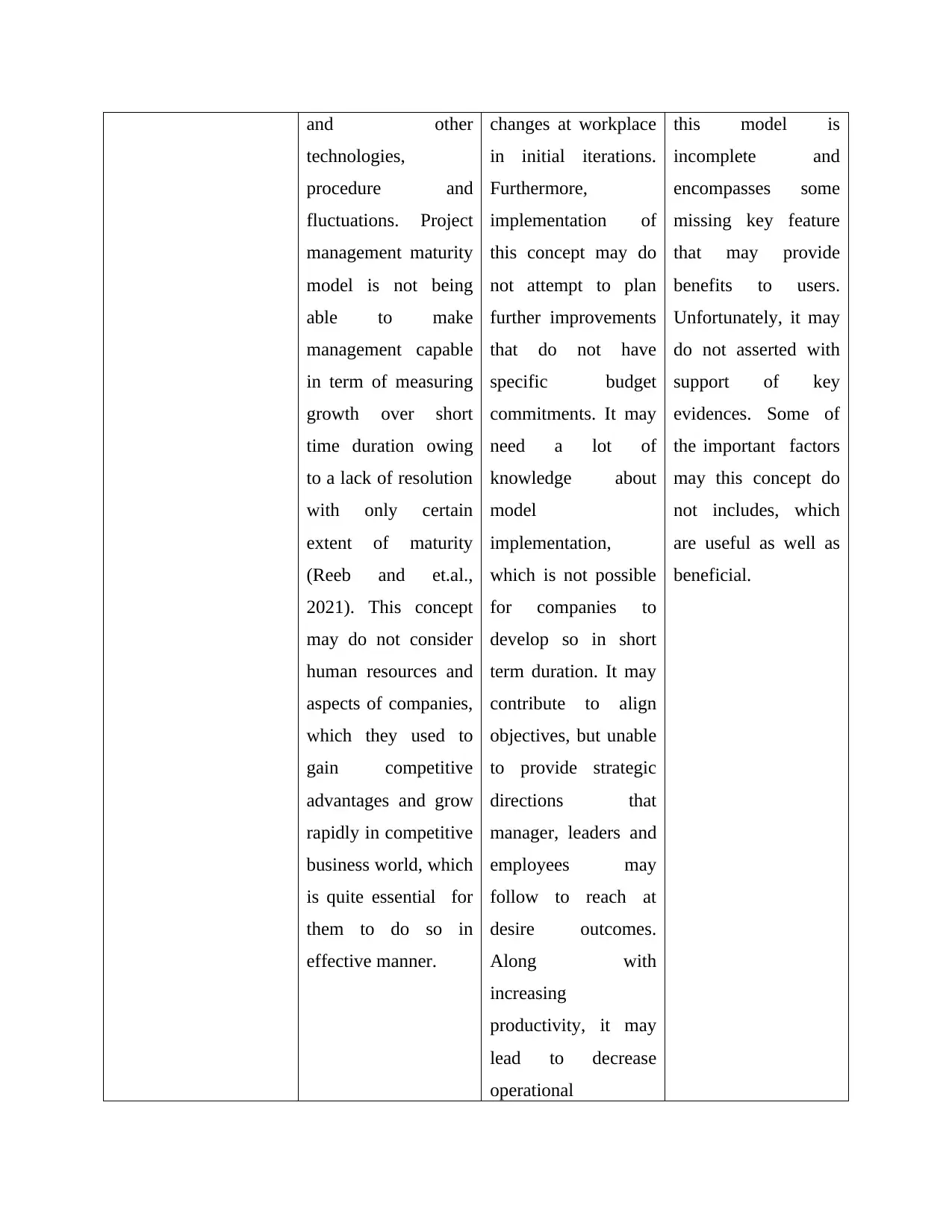
and other
technologies,
procedure and
fluctuations. Project
management maturity
model is not being
able to make
management capable
in term of measuring
growth over short
time duration owing
to a lack of resolution
with only certain
extent of maturity
(Reeb and et.al.,
2021). This concept
may do not consider
human resources and
aspects of companies,
which they used to
gain competitive
advantages and grow
rapidly in competitive
business world, which
is quite essential for
them to do so in
effective manner.
changes at workplace
in initial iterations.
Furthermore,
implementation of
this concept may do
not attempt to plan
further improvements
that do not have
specific budget
commitments. It may
need a lot of
knowledge about
model
implementation,
which is not possible
for companies to
develop so in short
term duration. It may
contribute to align
objectives, but unable
to provide strategic
directions that
manager, leaders and
employees may
follow to reach at
desire outcomes.
Along with
increasing
productivity, it may
lead to decrease
operational
this model is
incomplete and
encompasses some
missing key feature
that may provide
benefits to users.
Unfortunately, it may
do not asserted with
support of key
evidences. Some of
the important factors
may this concept do
not includes, which
are useful as well as
beneficial.
technologies,
procedure and
fluctuations. Project
management maturity
model is not being
able to make
management capable
in term of measuring
growth over short
time duration owing
to a lack of resolution
with only certain
extent of maturity
(Reeb and et.al.,
2021). This concept
may do not consider
human resources and
aspects of companies,
which they used to
gain competitive
advantages and grow
rapidly in competitive
business world, which
is quite essential for
them to do so in
effective manner.
changes at workplace
in initial iterations.
Furthermore,
implementation of
this concept may do
not attempt to plan
further improvements
that do not have
specific budget
commitments. It may
need a lot of
knowledge about
model
implementation,
which is not possible
for companies to
develop so in short
term duration. It may
contribute to align
objectives, but unable
to provide strategic
directions that
manager, leaders and
employees may
follow to reach at
desire outcomes.
Along with
increasing
productivity, it may
lead to decrease
operational
this model is
incomplete and
encompasses some
missing key feature
that may provide
benefits to users.
Unfortunately, it may
do not asserted with
support of key
evidences. Some of
the important factors
may this concept do
not includes, which
are useful as well as
beneficial.
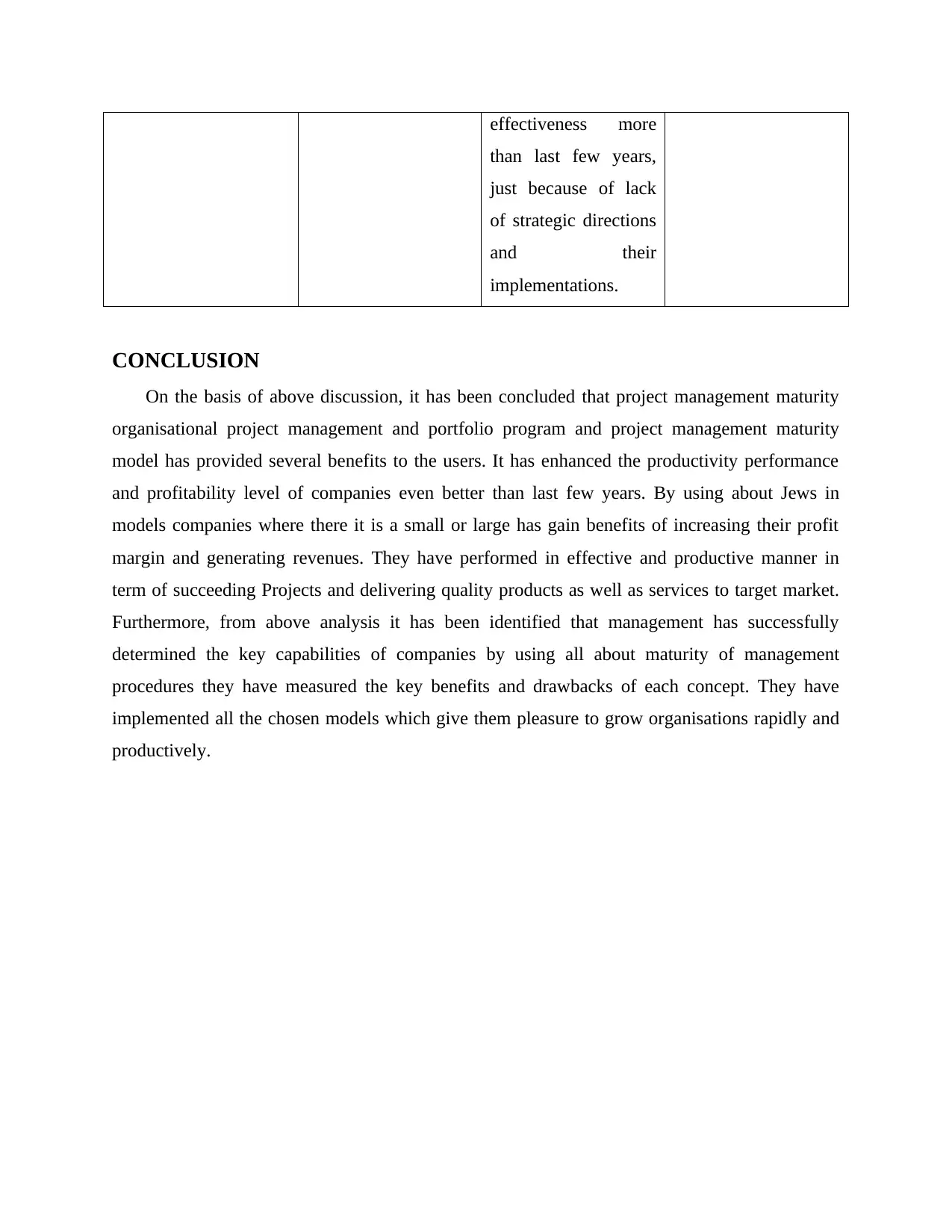
effectiveness more
than last few years,
just because of lack
of strategic directions
and their
implementations.
CONCLUSION
On the basis of above discussion, it has been concluded that project management maturity
organisational project management and portfolio program and project management maturity
model has provided several benefits to the users. It has enhanced the productivity performance
and profitability level of companies even better than last few years. By using about Jews in
models companies where there it is a small or large has gain benefits of increasing their profit
margin and generating revenues. They have performed in effective and productive manner in
term of succeeding Projects and delivering quality products as well as services to target market.
Furthermore, from above analysis it has been identified that management has successfully
determined the key capabilities of companies by using all about maturity of management
procedures they have measured the key benefits and drawbacks of each concept. They have
implemented all the chosen models which give them pleasure to grow organisations rapidly and
productively.
than last few years,
just because of lack
of strategic directions
and their
implementations.
CONCLUSION
On the basis of above discussion, it has been concluded that project management maturity
organisational project management and portfolio program and project management maturity
model has provided several benefits to the users. It has enhanced the productivity performance
and profitability level of companies even better than last few years. By using about Jews in
models companies where there it is a small or large has gain benefits of increasing their profit
margin and generating revenues. They have performed in effective and productive manner in
term of succeeding Projects and delivering quality products as well as services to target market.
Furthermore, from above analysis it has been identified that management has successfully
determined the key capabilities of companies by using all about maturity of management
procedures they have measured the key benefits and drawbacks of each concept. They have
implemented all the chosen models which give them pleasure to grow organisations rapidly and
productively.
⊘ This is a preview!⊘
Do you want full access?
Subscribe today to unlock all pages.

Trusted by 1+ million students worldwide
1 out of 14
Related Documents
Your All-in-One AI-Powered Toolkit for Academic Success.
+13062052269
info@desklib.com
Available 24*7 on WhatsApp / Email
![[object Object]](/_next/static/media/star-bottom.7253800d.svg)
Unlock your academic potential
Copyright © 2020–2025 A2Z Services. All Rights Reserved. Developed and managed by ZUCOL.





